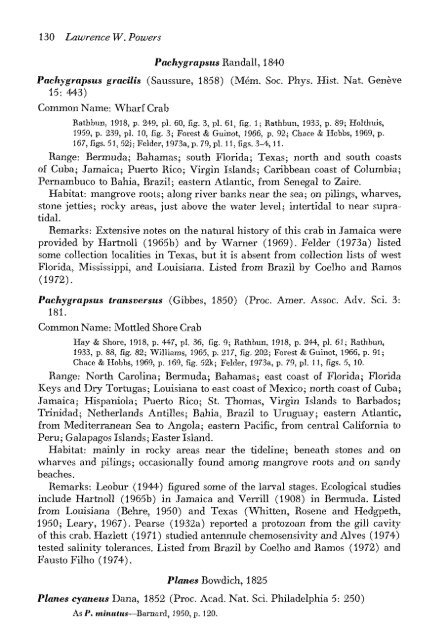Create successful ePaper yourself
Turn your PDF publications into a flip-book with our unique Google optimized e-Paper software.
130 Lawrence W. Powers<br />
Pachygrapsus Randall, 1840<br />
Pachygrapsus gracilis (Saussure, 1858) (Mem. Soc. Phys. Hist. Nat. Geneve<br />
15: 443)<br />
Common Name: Wharf Crab<br />
Rathbun, 1918, p. 249, pi. 60, fig. 3, pi. 61, fig. 1; Rathbun, 1933, p. 89; Holthuis,<br />
1959, p. 239, pi. 10, fig. 3; Forest & Guinot, 1966, p. 92; Chace & HOVDS, 1969, p.<br />
167, figs. 51, 52); Felder, 1973a, p. 79, pi, 11, figs. 3-4,11.<br />
Range: Bermuda; Bahamas; south Florida; Texas; north and south coasts<br />
of Cuba; Jamaica; Puerto Rico; Virgin Islands; Caribbean coast of Columbia;<br />
Pemambuco to Bahia, Brazil; eastern Atlantic, from Senegal to Zaire.<br />
Habitat: mangrove roots; along river banks near the sea; on pilings, wharves,<br />
stone jetties; rocky areas, just above the water level; intertidal to near supratidal.<br />
Remarks: Extensive notes on the natural history of this crab in Jamaica were<br />
provided by HartnoU (1965b) and by Warner (1969). Felder (1973a) listed<br />
some collection localities in Texas, but it is absent from collection lists of west<br />
Florida, Mississippi, and Louisiana. Listed from Brazil by Coelho and Ramos<br />
(1972).<br />
Pachygrapsus transversus (Gibbes, 1850) (Proc. Amer. Assoc. Adv. Sci. 3:<br />
181.<br />
Common Name: Mottled Shore Crab<br />
Hay & Shore, 1918, p. 447, pi, 36, fig, 9; Rathbun, 1918, p. 244, pi. 61; Rathbun,<br />
1933, p. 88, fig. 82; Williams, 1965, p. 217, fig. 202; Forest & Guinot, 1966, p. 91;<br />
Chace & Hobbs, 1969, p. 169, fig, 52k; Felder, 1973a, p. 79, pi. 11, figs. 5, 10.<br />
Range: North Carolina; Bermuda; Bahamas; east coast of Florida; Florida<br />
Keys and Dry Tortugas; Louisiana to east coast of Mexico; north coast of Cuba;<br />
Jamaica; Hispaniola; Puerto Rico; St. Thomas, Virgin Islands to Barbados;<br />
Trinidad; Netherlands Antilles; Bahia, Brazil to Uruguay; eastern Atlantic,<br />
from Mediterranean Sea to Angola; eastern Pacific, from central California to<br />
Peru; Galapagos Islands; Easter Island.<br />
Habitat: mainly in rocky areas near the tideline; beneath stones and on<br />
wharves and pilings; occasionally found among mangrove roots and on sandy<br />
beaches.<br />
Remarks: Leobur (1944) figured some of the larval stages. Ecological studies<br />
include Hartnoll (1965b) in Jamaica and Verrill (1908) in Bermuda. Listed<br />
from Louisiana (Behre, 1950) and Texas (Whitten, Rosene and Hedgpeth,<br />
1950; Leary, 1967). Pearse (1932a) reported a protozoan from the gill cavity<br />
of this crab. Hazlett (1971) studied antennule chemosensivity and Alves (1974)<br />
tested salinity tolerances. Listed from Brazil by Coelho and Ramos (1972) and<br />
FaustoFilho (1974).<br />
PZancs Bowdich, 1825<br />
Planes cyaneus Dana, 1852 (Proc. Acad. Nat. Sci. Philadelphia 5: 250)<br />
As P. minutus—Barnard, 1950, p. 120.

















